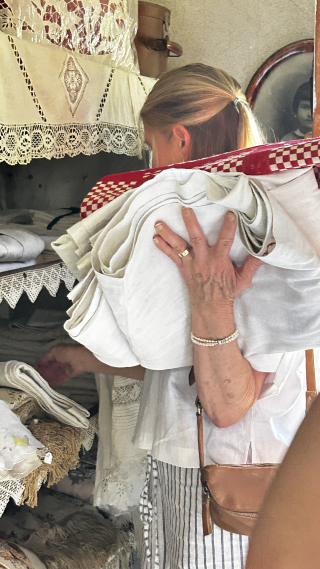Learning about French history and culture through antiques is one of the reasons I love the brocante.
Today, I had the pleasure of meeting Teresa and her daughter Abby. Abby asked me to plan a mini French la Vie day to surprise her mother since she knew she had read my blog for at least 15 years. It is always a pleasure to meet those who read my blog. Conversing in advance with them, I had some ideas about where we would venture.
Brocanting for linens, paintings, kitchenware, and pottery and visiting the seaside were on their list.
They hit the jackpot. That Brocante Bug knows where to flutter, where to bite, and often where to land and kiss.
Luckily, because it wasn’t planned that they would buy more than a few pieces to fit in their suitcase, the transporter I worked with was open, and nearby so we took the monogrammed linens, faience, and many other beautiful finds to him to pack and send.
There was a berry-ripe mulberry tree in the parking lot; another similarity between Teresa and I was our childhood memories of hot summer days under the thick mulberry canopy picking mulberries. The sweetness of memory and the coolness under its long branches made the parking lot seem like a gold mine.
Teresa also grew up in California, raised in the country with boundless land to explore, rode motorcycles, it seemed as our day unfolded we had more and more in common.
At our last stop, this enormous pot stood proudly at the entrance. Instant admiration I had for the old repair work that it adorns more worthy than a string of pearls.
I learned that this particular shape and design is a bugadier.
Century-old terre cuite storage “Jarres” were typically used for olive oil, olives, and such. The potteries of Biot and other areas in Provence were well known for producing various household items, including “Bugadiers.” Bugade in French means laundry and a Bugadier would have been used to store and wash laundry. Before the washing machine, there was no need to go to the river to do laundry if you had a Bugadier.
They were usually built into the wall or floor of a laundry room and often broke as they were removed, which is why these 18th-century versions are hard to find in one piece. As you can see, the Bugadier in the photo has wired staples holding it together. Of course, I find that extra charming.
It will take three to four people to load it in the truck. Guess where it is going?


Leave a Reply